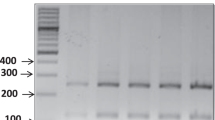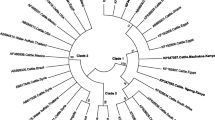Abstract
Babesiosis is a haemoparasitic disease with high economical losses in livestock industry worldwide. The early diagnosis and successful therapy of babesiosis belong to the key steps of control and health management of livestock. Ethanol-fixed blood samples of 400 sheep were analyzed for Babesia infection. Reverse line blot (RLB) was established specifically for Theileria lestoquardi, Theileria (China 1), Theileria (China 2), Theileria ovis, Theileria separata, Babesia ovis, Babesia motasi, Babesia crassa, and Babesia (Lintan). The DNA was extracted from the ethanol-fixed blood samples and amplified with a common primer pair derived from 18S rRNA gene, amplifying both Theileria spp. as well as Babesia spp. Regarding the differences in the length of nucleotide sequences of the polymerase chain reaction (PCR) products obtained from Theileria spp. and Babesia spp., the PCR products derived from Babesia spp. were out screened and analyzed by RLB. The RLB analysis showed that 28 samples within the 400 blood samples were B. ovis positive. No B. motasi, B. crassa, or Babesia (Lintan) could be detected. The sequence analysis of one PCR product as a representative for other B. ovis-positive PCR products confirmed the results of RLB. Our results and the results of other investigators showed that B. ovis could be considered as a main causative agent of sheep babesiosis in Iran. Furthermore, our results also showed that RLB can be used as a reliable method for a simultaneous differentiation of Theileria and Babesia species from each other.

Similar content being viewed by others
References
Ahmed J, Yin H, Schnittger L, Jongejan F (2002) Ticks and tick-borne diseases in Asia with special emphasis on China. Parasitol Res 88:S51–S55
Aktas M, Altay K, Dumanli N (2007) Determination of prevalence and risk factors for infection with Babesia ovis in small ruminants from Turkey by polymerase chain reaction. Parasitol Res 100:797–802
Altay K, Aktas M, Dumanli N (2008) Detection of Babesia ovis by PCR in Rhipicephalus bursa collected from naturally infested sheep and goats. Res Vet Sci 85:116–119
Bai Q, Liu G, Ren J, Li X (2002) Isolation and preliminary characterization of a large Babesia sp. from sheep and goats in the eastern part of Gansu Province, China. Parasitol Res 88:16–21
Guan G, Chauvin A, Luo J, Inoue N, Moreau E, Liu Z, Gao J, Thekisoe OM, Ma M, Liu A, Dang Z, Liu J, Ren Q, Jin Y, Suqimoto C, Yin H (2008) The development and evaluation of a loop-mediated idothermal amplification (LAMP) method for detection of Babesia spp. infective to sheep and goats in China. Exp Parasitol 120(1):39–44
Gubbels JM, de Vos AP, van der Weide M, Viseras J, Schouls LM, de Vries E, Jongejan F (1999) Simultaneous detection of bovine Theileria and Babesia species by reverse line blot hybridization. J Clinic Microb 37(6):1782–1789
Hashemi-Fesharki R, Uilenberg G (1981) Babesia crassa n.sp. (Sporozoa, Babesiidae) of domestic sheep in Iran. Vet Q 2:3–14
Heidarpour Bami M, Khazraiinia P, Haddadzadeh HR, Kazemi B (2010) Identification of Theileria species in sheep in the eastern half of Iran using nested PCR-RFLP and microscopic techniques. Iran J Vet Res 11(3):262–266
Inci A, Ica A, Yildirim A, Duzlu O (2010) Identification of Babesia and Theileria species in small ruminants in central Anatolia (Turkey) via reverse line blotting. Turk J Anim Sci 34(2):205–210
Levine ND (1985) Veterinary protozoology. Iowa State University Press, Ames
Lewis D, Holman MR, Purnell RE, Young ER (1981) Investigations on Babesia motasi isolated from Wales. Res Vet Sci 31:239–243
Luo J, Yin H (1997) Theileriosis of sheep and goats in China. Trop Anim Health Prod 29:8–10
Mehlhorn H, Schein E, Ahmed JS (1994) Theileria. In: Kreier JP (ed) Parasitic protozoa, vol 7. Academic, San Diego, pp 217–304
Niu Q, Luo J, Guan G, Ma M, Liu Z, Liu A, Dang Z, Gao J, Ren Q, Li Y, Liu J, Yin H (2009) Detection and differentiation of ovine Theileria and Babesia by reverse line blotting in China. Parasitol Res 104:1417–1423
Persing DH, Herwaldt BL, Glaser C, Lane RS, Thomford JW, Mathiesen D, Krause PJ, Phillip DF, Conrad PA (1995) Infection with a Babesia-like organism in northern California. N Engl J Med 332(5):298–303
Ray HN, Raghavachari K (1941) Observations on Babesia foliata n.sp. from a sheep. Ind J Vet Sci 11:239–242
Razmi GR, Naghibi A, Aslani MR, Dastjerdi K, Hosseini H (2003) An epidemiological study on Babesia infection in Mashhad suburb, Khorasan province, Iran. Small Rumin Res 50:39–44
Sadeghi Dehkordi Z, Zakeri S, Nabian S, Bahonar A, Ghasemi F, Noorollahi F, Rahbari S (2010) Molecular and biomorphometrical identification of ovine babesiosis in Iran. Iranian J Parasitol 5(4):21–30
Sarwar SM (1935) A hitherto undescribed piroplasm of goats (Piroplasma taylori). Ind J Vet Sci 5:171–176
Schnittger L, Yin H, Jianxun L, Ludwig W, Shayan P, Rahbari S, Voss-Holtmann A, Ahmed JS (2000) Ribosomal small-subunit RNA gene-sequence analysis of Theileria lestoquardi and a Theileria species highly pathogenic for small ruminants in China. Parasitol Res 86:352–358
Schnittger L, Yin H, Qi B, Gubbels MJ, Beyer D, Niemann S, Jongejan F, Ahmed JS (2004) Simultaneous detection and differentiation of Theileria and Babesia parasites infecting small ruminants by reverse line blotting. Parasitol Res 92(3):189–196
Shayan P, Hooshmand E, Nabian S, Rahbari (2008) Biometrical and genetical characterization of large Babesia ovis in Iran. Parsitol Res 103: 217–221
Shayan P, Nabian S (2008) The use of immunostaining for determination of Babesia and Theileria and gene expression of proliferation associated with nuclear protein in Theileria infected cells, Iranian. Vet J 3(3):21–29
Shayan P, Rahbari S (2005) Simultaneous differentiation between Theileria spp. and Babesia spp. on stained blood smear using PCR. Parasitol Res 97(4):281–286
Shayan P, Hooshmand E, Rahbari S, Nabian S (2007) Determination of Rhipicephalus spp. as vectors for Babesia ovis in Iran. Parasitol Res 101:1029–1033
Soulsby EJL (1982) Helminths, arthropods and protozoa of domesticated animals, 7th edn. Bailliere Tindall, London, pp 706–728
Sulaiman EG, Arslan SH, Al-Obaidi QT, Daham E (2010) Clinical, haematological and biochemical studies of babesiosis in native goats in Mosul. Iraq J Vet Sci 24(1):31–35
Tanwar RK, Fakhruddin SAP, Gahlot AK, Sharma SN (2000) Clinico-haematological and therapeutic studies on caprine babesiosis. Intas Polivet 1(11):225–226
Thomford JW, Conrad PA, Boyce WM, Holman PJ (1993) Isolation and in vitro cultivation of Babesia parasites from free-ranging desert bighorn sheep (Ovis canadensis nelsoni) and mule deer (Odocoileus hemionus) in California. J Parasitol 79(1):77–84
Thomford JW, Conrad PA, Telford SR, Mathiesen D, Bowman BH, Spielman A, Eberhard ML, Herwaldt BL, Quick RE, Persing DH (1994) Cultivation and phylogenetic characterization of a newly recognized human pathogenic protozoan. J Infect Dis 169(5):1050–1056
Uilenberg G (2001) Babesiosis. In: Service MW (ed) Encyclopedia of arthropod-transmitted infections of man and domesticated animals. CABI, Wallingford, pp 53–60
Wenyon CM (1926) Protozoology, vol 3. Hafner Publishing Company, New York
Zaeemi M, Haddadzadeh HR, Khazraiinia P, Kazemi M, Bandehpour (2011) Identification of different Theileria species (Theileria lestoquardi, Theileria ovis and Theileria annulata) in naturally infected sheep using nested PCR-RFLP. Parasitol Res 108:837–843
Acknowledgments
This work was supported by a grant from the Islamic Azad University, Garmsar and Investigating Institute Molecular Biological System Transfer.
Author information
Authors and Affiliations
Corresponding author
Rights and permissions
About this article
Cite this article
Ranjbar-Bahadori, S., Eckert, B., Omidian, Z. et al. Babesia ovis as the main causative agent of sheep babesiosis in Iran. Parasitol Res 110, 1531–1536 (2012). https://doi.org/10.1007/s00436-011-2658-z
Received:
Accepted:
Published:
Issue Date:
DOI: https://doi.org/10.1007/s00436-011-2658-z




